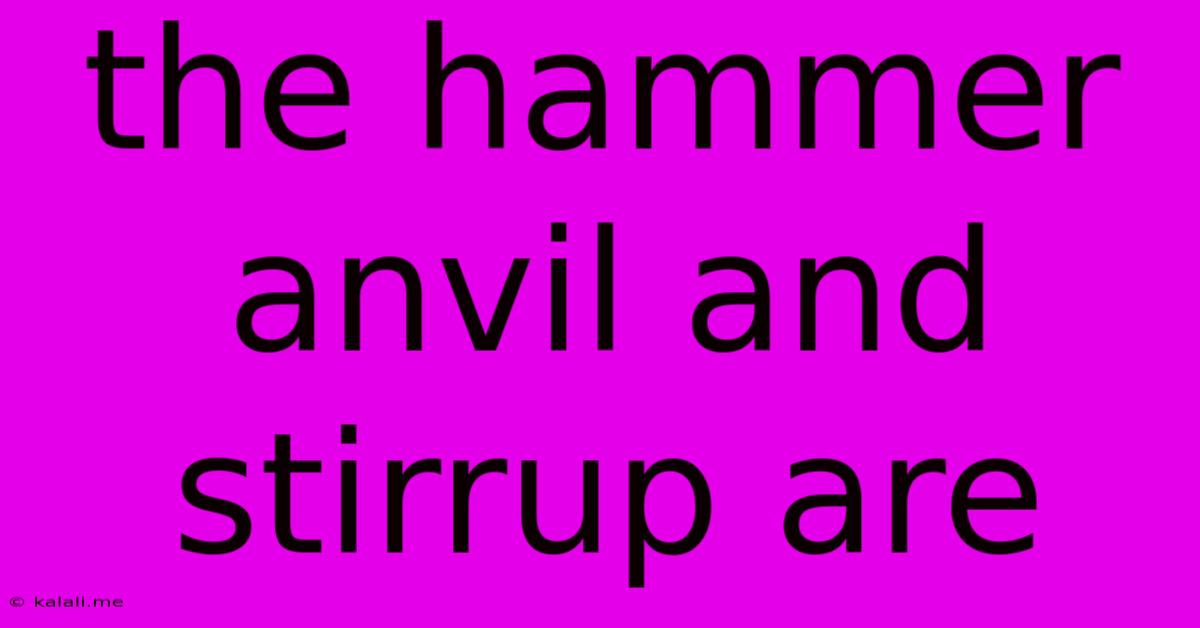The Hammer Anvil And Stirrup Are
Kalali
Jun 14, 2025 · 3 min read

Table of Contents
The Hammer, Anvil, and Stirrup: Tiny Bones, Huge Impact on Hearing
The malleus, incus, and stapes—better known as the hammer, anvil, and stirrup—are three incredibly small bones located in the middle ear. These ossicles, as they are also called, play a crucial role in the process of hearing, transferring sound vibrations from the eardrum to the inner ear. Understanding their function is key to appreciating the delicate mechanics of auditory perception. This article will delve into the anatomy, function, and potential problems associated with these vital structures.
What are the Hammer, Anvil, and Stirrup?
The hammer (malleus), anvil (incus), and stirrup (stapes) are the smallest bones in the human body. They form a chain that extends across the middle ear cavity, connecting the eardrum (tympanic membrane) to the oval window, a membrane-covered opening to the inner ear. This intricate linkage is essential for efficient sound transmission.
How They Work Together: The Mechanism of Hearing
The process begins when sound waves hit the eardrum, causing it to vibrate. These vibrations are then amplified and transmitted through the ossicular chain:
-
Malleus (Hammer): The malleus is attached to the eardrum. When the eardrum vibrates, it moves the malleus, initiating the chain reaction.
-
Incus (Anvil): The malleus is connected to the incus, which acts as a lever, further amplifying the vibrations and transmitting them to the stapes.
-
Stapes (Stirrup): The stapes, the smallest bone in the body, is connected to the incus and rests against the oval window. The vibrations transmitted through the malleus and incus cause the stapes to push against the oval window, creating pressure waves in the fluid-filled inner ear.
These pressure waves stimulate the hair cells within the cochlea (part of the inner ear), converting the mechanical vibrations into electrical signals that are then transmitted to the brain via the auditory nerve, allowing us to perceive sound.
The Importance of Amplification
The ossicular chain doesn't just transmit vibrations; it amplifies them. This amplification is vital because the impedance (resistance to sound transmission) between air (in the middle ear) and fluid (in the inner ear) is significantly different. Without the ossicles, most of the sound energy would be reflected back, resulting in significantly impaired hearing.
Potential Problems Affecting the Ossicles
Various conditions can affect the function of the hammer, anvil, and stirrup, leading to hearing loss. These include:
- Otosclerosis: A bone disease that causes abnormal bone growth around the stapes, restricting its movement.
- Trauma: Injuries to the head or middle ear can damage or dislocate the ossicles.
- Infection: Middle ear infections (otitis media) can sometimes damage the ossicles.
- Age-related changes: The ossicles can become stiff with age, reducing their ability to transmit vibrations effectively.
Conclusion: The Unsung Heroes of Hearing
The seemingly insignificant hammer, anvil, and stirrup are remarkably important components of the hearing mechanism. Their intricate interplay ensures efficient sound transmission and amplification, allowing us to perceive the world around us through the sense of hearing. Understanding their function highlights the complexity and delicate balance within the human auditory system. Any disruption to their function can significantly impact hearing ability, underscoring the importance of protecting this vital part of our anatomy.
Latest Posts
Latest Posts
-
What Two Countries Share The Longest Border
Jun 15, 2025
-
Parts Of A Three Phase Motor
Jun 15, 2025
-
What Do News Reporters Say At The Beginning
Jun 15, 2025
-
University Of Phoenix Requirements For Admission
Jun 15, 2025
-
Average Gpa For University Of Illinois
Jun 15, 2025
Related Post
Thank you for visiting our website which covers about The Hammer Anvil And Stirrup Are . We hope the information provided has been useful to you. Feel free to contact us if you have any questions or need further assistance. See you next time and don't miss to bookmark.